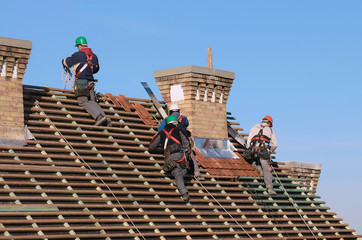Roofing maintenance is an essential part of any home owner’s routine. It can prevent major repairs from becoming costly and time-consuming.

Regular inspections (preferably twice per year) are key to maintaining your roof. These inspections can spot small problems that can easily be fixed if addressed early on.
Inspecting your roof is an important part of ensuring that it remains in good condition. This is especially true when it comes to detecting potential issues that could lead to costly repairs in the future.
As your roof is constantly exposed to the elements, it is necessary to inspect your roofing system periodically to ensure that it is in the best condition possible. This can be done by performing visual inspections of the different parts of your roof and by contacting a professional to perform an in-depth evaluation of your property’s roofing system.
By proactively taking care of your roof, you can prolong its lifespan. This is especially true when you schedule regular roof maintenance and inspections.
You can check the shingles for any deterioration that is evident (bald spots, granule loss, and significant curling), which are all signs of an aging roof that will need replacement sooner than later. Another sign of aging is moss or lichen growing on the roof.
It is also important to check the gutters for any clogged areas that are causing water to leak into your home. This is a common cause of damage to your roof and can also lead to extensive damage inside your home.
If you notice any of these problems, it is crucial to get the issue fixed right away. It is important to hire a qualified professional to perform the repairs, as they will know how to make these repairs effectively and safely.
Some professionals even use thermal imaging technology to detect “hot spots” on the roof that are a warning sign of damaged shingles. This can be a valuable tool for identifying potential problems, and it can help cut down on the time that repairing your roof will take.
The most critical time to have your roof inspected is in the fall, before winter sets in. This is because freezing temperatures can compromise the success of new roof installations and repairs.
In addition, the fall is an excellent time to start addressing any moss or lichen that is already present on your roof. It can take many months for these invasive invaders to become a problem, but in the fall, you have a chance to begin the process of treating them before they completely destroy your roof and cause damage to your home’s interior.
When a roof is inspected, the inspector will look at flashing, the metal pieces that protect chimneys, skylights, vents, and other penetrations. This is because these areas are vulnerable to leaks that can cause extensive damage if left unchecked.
Inspecting the flashing is a part of all roofing inspections. It is a vital component of the roof system that is often overlooked. It is also essential for the safety of your home and family.
The roof is made up of various parts, including valleys (areas where two slopes meet), vents, skylights, chimneys, and dormers (structures that extend from the side of the house). These are all places where water can seep through a crack and into the home.
To prevent this, modern builders install flashing at these points to help direct water away from the joint and into gutters. This way, the home stays dry and does not suffer from water damage.
Flashing is a durable material that can last for a long time, especially if it is well installed and maintained. It is made of different materials, including aluminum and copper.
Aside from its protective functions, flashing is also used for decorative purposes. It can smooth out openings between shingles and other components of the roof, giving it a more finished appearance.
Many flashings have caulk around their edges, which is also important for sealing against moisture. This tends to degrade over time, so it is important to check for peeling, cracking, pitted spots, or missing beads.

